Bathtub Reglazing: A Complete Guide to Restoration
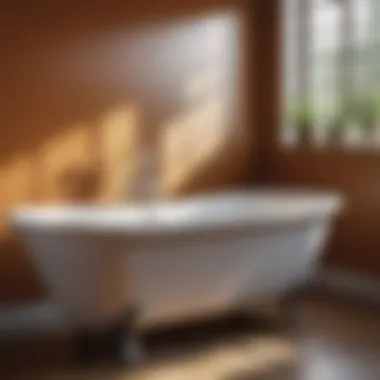
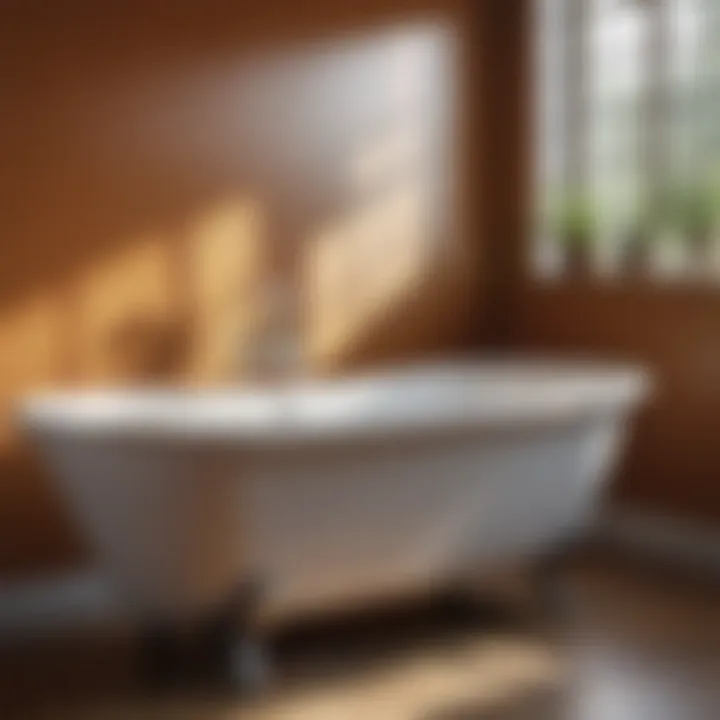
Intro
In recent years, as environmental concerns and economic factors loom large for many households, the choice to reglaze rather than replace has gained traction. It is an effective way to achieve a fresh look without the hefty price tag associated with new installations. This article aims to serve as a comprehensive resource, empowering homeowners and renters to explore the nuances of reglazing their bathtubs. From the techniques employed to the potential pitfalls, we’ll delve into a range of scenarios, helping you arrive at the best decision for your personal bathing oasis.
Design Inspirations
When transforming your bathtub through reglazing, design considerations play a pivotal role. Homeowners interested in enhancing their bathrooms should consider trending styles and harmonious color palettes that can elevate the overall aesthetic of the space.
Trending Styles
As we skim through popular bathroom design trends, sleek modern aesthetics are often seen as the gold standard. Minimalist designs prioritize clean lines and simplicity, leading many to choose neutral colors like whites, grays, and soft beiges for their reglazed tub. In contrast, vintage or rustic styles can bring warmth to a bathroom with earthy tones or pastel shades.
Additionally, the resurgence of bold patterns and textures has created interest in tropical or bohemian styles, where deep blues or vibrant greens can make a striking statement when beautifully finished.
- Sleek Modern: Whites and grays, focus on minimalism.
- Vintage/Rustic: Earthy tones, soft pastels for a warm aesthetic.
- Bold Patterns: Tropical hues or bohemian mixes for statement making.
Color Palettes
Choosing the right color palette is crucial, as the bathtub serves as a focal point in the room. In this context, homeowners should pay attention to the interplay between the selected shades and other bathroom elements such as tiles, fixtures, and accessories. Here are some popular combinations:
- Monochromatic: All shades of a single color to create a harmonious feel.
- Contrasting: Bold colors alongside neutral tones for an unexpected visual punch.
- Earthy Mixes: Utilizing greens, browns, and blues brings a soothing nature-inspired theme.
Ultimately, selecting a color palette that reflects your personality and complements your home decor is essential. Ultimately, through careful consideration, reglazed bathtubs can be made exquisite while adding value to your personal haven.
Culmination
Through engaging in the process of reglazing your bathtub, one can achieve a tailored result that resonates with personal style preferences. This process, while requiring attention to detail and planning, ensures that your bathing space remains functional and aesthetically pleasing. The insights shared throughout this article will serve as a guide, helping you to navigate the complexities of bathtub reglazing with confidence.
Understanding Bathtub Reglazing
In the realm of home improvement, bathtub reglazing stands as a pivotal technique that offers homeowners a chance to rejuvenate their bathroom aesthetic without the financial burden of complete replacement. Understanding this process is not just about knowing how to reglaze; it's about appreciating the significance it holds in maintaining and enhancing one's living space. Through this exploration, readers can discern the practical and emotional benefits of their decision, illustrating how reglazing can positively affect both the environment and one's home life.
Definition and Purpose
Bathtub reglazing, also referred to as refinishing, involves applying a new coating to an existing bathtub to restore its original luster and extend its usability. The primary purpose of reglazing is to breathe new life into an old fixture, offering an alternative to replacing it. Replacement often comes with high costs, not to mention the fuss of removal and installation. Therefore, reglazing becomes a sensible and often necessary option for homeowners wanting to enhance their bathing experience without pushing their budget beyond reason.
The process typically includes cleaning the surface, repairing any chips or cracks, and applying specialized coatings that bond to the bathtub material. This not only improves the appearance but also creates a waterproof, durable finish that resists mildew and staining.
Historical Context
Looking back, bathtub reglazing emerged as a response to the growing demand for easy and cost-effective bathroom renovations. In the mid-20th century, bathtubs were most often made from cast iron or enameled steel. As homeownership rates increased, these older tubs began to show signs of wear and tear after years of use and neglect. Rather than tearing out these heavy fixtures, homeowners sought methods to refurbish them, minimizing waste and sticking to tighter budgets during economic downturns.
The actual technique of reglazing has been around for decades, but it gained prominence in the 1980s when refinishing kits became accessible to the average DIY-er. Before that, it was primarily a service provided by professionals, often involving a complex process that was not widely understood by homeowners. Today, with advancements in materials and methods, reglazing not only offers a solution for aesthetic issues but also encourages sustainability by reducing landfill waste resulting from bathtub disposals.
Bathtub reglazing now represents a fusion of art and science, allowing for customization that can cater to contemporary design trends while maintaining historical integrity. The importance can't be overstated—it provides significant opportunities for homeowners to save money, reduce waste, and create beautiful spaces that reflect their personal style.
The Benefits of Reglazing
Bathtub reglazing isn't just a cosmetic touch-up for your bathroom; it’s a vital process that carries with it a wealth of benefits, both tangible and intangible. When considering the state of your bathtub, reglazing can often be the key that unlocks a fresh perspective on home improvement. The essence of this process is to breathe new life into your existing fixture, allowing you to save on costs while enhancing your personal space. Here, we delve into the specific benefits that highlight why reglazing is such a favorable option for homeowners and renters alike.
Cost-Effectiveness
Choosing to reglaze your bathtub instead of opting for a complete replacement can bring substantial savings to your wallet. A full bathtub replacement can easily run into the thousands of dollars, considering the cost of materials, labor, and potential plumbing adjustments. On the flip side, reglazing typically requires only a fraction of that expense. For a few hundred dollars, you can achieve a results that resonate with an entirely new bathtub look. This doesn't just save you money upfront; it also minimizes the potential disruption that comes with tearing out old fixtures and installing new ones.
In addition, reglazing often takes a fraction of the time compared to a full remodel. Less time spent on renovation means less disruption to your daily life, allowing you to enjoy your bathing space more swiftly. Overall, reglazing represents a pragmatic choice for those looking to maintain their home without breaking the bank.
Aesthetic Improvement
The visual aspect of a bathroom can significantly impact the overall feel of a home. A poorly maintained bathtub can drag down the aesthetic appeal, making even the most elegant fixtures look tarnished. Reglazing offers a fresh coat that transforms worn-out tubs into gleaming surfaces that look new and inviting. Whether you're aiming for a classic white finish or a more modern color to match current design trends, reglazing allows for a degree of customization.
Not only does this process improve the look of the tub itself, but it also plays a crucial role in enhancing the overall ambiance of the bathroom. With a fresh, shiny surface, your bathing experience becomes more enjoyable. An inviting tub can serve as a focal point, capturing attention in a room. In turn, this can boost the resale value of your home, making it more attractive to prospective buyers.
Environmental Considerations
When it comes to home renovations, the environmental impact is often overlooked. Reglazing stands out as a magnificent eco-friendly option. Instead of sending an old bathtub to the landfill, reglazing allows you to keep the existing structure and restore it to its former glory. This not only minimizes waste, but it also conserves resources needed to manufacture new fixtures.
Additionally, you may choose eco-friendly products that further diminish your environmental footprint. Some reglazing materials are designed to emit fewer volatile organic compounds (VOCs), which can improve indoor air quality. It’s a double win: you get a refreshed bathroom and contribute positively to environmental sustainability.
"Reglazing isn’t just a maintenance project; it’s also a mindful choice for the planet."
In summary, the benefits of bathtub reglazing extend beyond mere aesthetics. This cost-effective, visually transforming, and environmentally sound option makes it an attractive alternative to replacement. Homeowners can enjoy a powerful sense of accomplishment from revitalizing their bathrooms without the hefty price tag and ecological toll that often comes with traditional renovations.
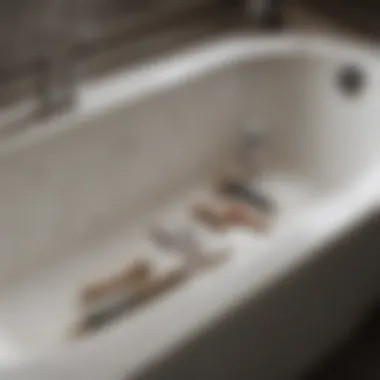
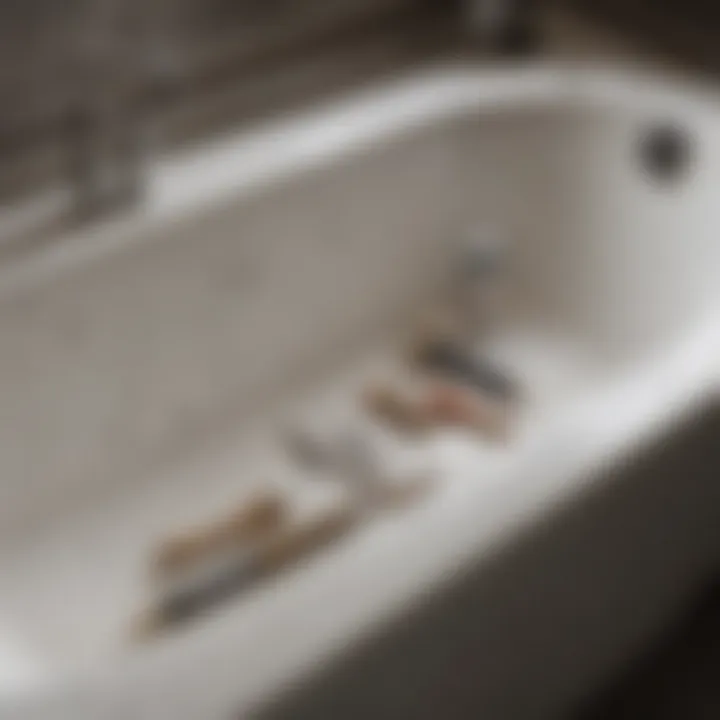
The Reglazing Process
When it comes to revitalizing an aging bathtub, the reglazing process holds significant weight. It represents the crux of transforming a worn and stained fixture into a sparkling centerpiece of the bathroom. This segment delves into the essential elements of the reglazing process, allowing homeowners to grasp its importance fully and understand how to execute it effectively.
Preparation Techniques
Proper preparation is paramount in the reglazing process. This stage is often likened to laying the foundation for a sturdy house. If the groundwork is shaky, the entire structure may crumble. Here’s why preparation matters and how to get it right:
- Surface Cleaning: Before any product is applied, it's essential to scrub the tub's surface thoroughly. Use a robust cleaning solution that can cut through grime and soap scum. A clean surface ensures that the reglazing materials adhere properly.
- Repairing Damage: Any chips or cracks in the bathtub need attention. Fill these imperfections with an appropriate filler material and sand them down to create a smooth surface.
- Sanding: Lightly sanding the entire surface helps to create a more effective bond for the reglazing materials. It's almost like giving the surface a 'tooth' to grip onto the new finish better. Using a fine-grit sandpaper is advisable.
- Masking: Use painter’s tape to mask off areas surrounding the tub, including tiles and fixtures. This prevents overspray and keeps your bathroom looking sharp and clean.
Application of Reglazing Materials
Once the preparation is complete, it’s time to bring out the reglazing materials. This segment can be seen as the artist applying paint to a canvas, requiring precision and technique:
- Choosing Materials: Opt for high-quality reglazing kits specifically designed for bathtubs. These often contain epoxy or polyurethane coatings that provide durability and a shiny finish.
- Mixing Components: If you're using a kit that requires mixing components, it's important to follow the manufacturer’s instructions closely. Achieving the correct consistency is key to successful application.
- Spraying vs. Rolling: Most professionals prefer spraying the reglazing materials for a smoother finish. If you're going the DIY route, consider an HVLP (High Volume Low Pressure) sprayer for even application. If rolling, ensure to use a foam roller to avoid any texture that could affect aesthetics.
- Layering: Applying multiple thin coats rather than one thick layer helps prevent drips and ensures an even finish. It's usually recommended to wait a few hours between coats, depending on the materials used.
Curing and Finishing
The final phase of the reglazing process is curing and finishing, a critical aspect often overlooked by DIYers. In a way, this is akin to letting a cake cool before icing it; you wouldn’t want to rush it:
- Curing Time: It’s crucial to allow adequate curing time to ensure that the newly applied surface hardens correctly. Most reglazing products recommend a curing time of 24 to 48 hours before use. This is not just a suggestion, but a necessity to achieve the durability intended.
- Ventilation: Proper ventilation during the curing process is essential. Open windows and use fans to help the chemicals dissipate. This not only enhances the quality of the finish but also contributes to safety.
- Final Touches: Once curing is complete, inspect for any imperfections or areas needing touch-ups. If necessary, sand lightly and apply a final coat. Finally, clean up any masking tape and give your tub a gentle clean with a non-abrasive cleaner.
Remember: The effort put into the reglazing process can lead to a bathtub that looks new without the hefty price tag of replacement, making it a wise investment for both aesthetics and budget.
Following a careful regimen in these three stages ensures that your reglazing project yields results that speak volumes about your home improvement acumen. This diligence not only enhances the bathroom’s appearance but also prolongs the life of the bathtub itself.
Common Pitfalls in Reglazing
Reglazing a bathtub is no small task; it requires careful thought and attention to detail. Undoubtedly, avoiding common pitfalls can mean the difference between a successful project and a disaster. Knowing what these missteps are can save time, money, and effort. It also ensures that the bathtub not only looks good but also lasts longer. Here, we’ll look at three significant pitfalls: poor surface preparation, inadequate ventilation, and the selection of inappropriate products.
Poor Surface Preparation
One of the most critical steps in the reglazing process involves surface preparation. Without proper prep work, the entire project could end up being a wasted effort. Think of it like trying to paint a wall without cleaning it first; the paint won’t stick, and the results will be subpar.
Before reglazing, it's essential to clean the surface thoroughly and check for any damage like cracks or chips. Simple tasks like sanding down rough patches may seem trivial, but they make a world of difference in the adhesion of the reglazing material. If the surface isn’t adequately prepared, the new finish can peel or bubble, leading to a need for more repairs down the line.
Inadequate Ventilation
When it comes to working with chemicals in the reglazing process, ventilation is not just a suggestion; it’s a necessity. Poor ventilation can trap harmful fumes, creating an unsafe working environment. Not to mention, lack of airflow can affect how the reglazing material cures.
Proper ventilation can include opening windows and using fans to circulate air. Taking these precautions helps not only in safeguarding one’s health but also in ensuring that the reglazing adheres correctly and cures fully. It’s better to take a little extra time to set up a ventilated area than to rush into work and potentially compromise one’s safety—and the final result.
Choosing Inappropriate Products
The market today is flooded with numerous products for reglazing, making it easy to get lost in the choices. However, selecting the wrong products can lead to failure before the process even begins. It’s important to choose high-quality products that suit your specific bathtub material, whether it’s ceramic, fiberglass, or acrylic.
Reading labels and checking reviews can provide insight into which products perform well. Bypassing this step might lead to using materials that may not adhere or, even worse, could react negatively.
"Choosing the right materials is like picking the right ingredients for a dish; the outcome hinges on that choice."
Finale
In summary, being aware of common pitfalls when reglazing your bathtub means being proactive about your project. From the outset, prioritize surface preparation, ensure adequate ventilation, and carefully consider your material choice. By avoiding these missteps, you can rest assured that your reglazing project will not only beautify your bathroom but will also stand the test of time.
Reglazing Versus Replacement
When considering bathroom renovations, the choice between reglazing a bathtub or replacing it entirely often looms large. It’s about weighing options that cater to both aesthetics and budget. Each pathway has its pros and cons, and understanding these can empower you as a homeowner or renter to make more informed decisions about your bathing sanctuary.
Cost Comparison
One key factor in making the decision is the financial aspect. Generally speaking, reglazing a bathtub is far less expensive than purchasing a new one and having it installed. The average cost of reglazing can range from $300 to $800, while a new bathtub, along with installation, could easily exceed $1,500. Not to mention that breaching the walls for pipes and related plumbing work can escalate costs even further.
For those keeping an eagle eye on budget, reglazing presents a sensible, cost-effective solution. Just like balancing the books, it’s about getting the most bang for your buck. A renewed finish can have your tub looking as good as new, allowing for a fresh start without the heavy price tag that accompanies replacements.
Longevity and Durability
While cost is significant, longevity and durability also play vital roles in the decision-making process. A reglazed tub can last anywhere from 10 to 15 years if maintained properly. However, many may wonder about the suitability of reglazing. If the surface is adequately prepared and high-quality materials are used, the durability is often commendable. On the other side of the coin, a brand-new bathtub will typically offer a longer lifespan due to the absence of previous wear and tear.
Replacement may represent the ultimate assurance of durability. For families with active lifestyles or those who expect heavy usage, investing in a new tub might ultimately provide peace of mind, even if it comes at a higher upfront cost. However, with careful consideration and proper care, a reglazed tub can certainly hold its own over the years.
Design Flexibility
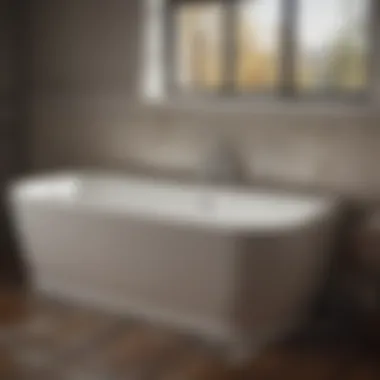
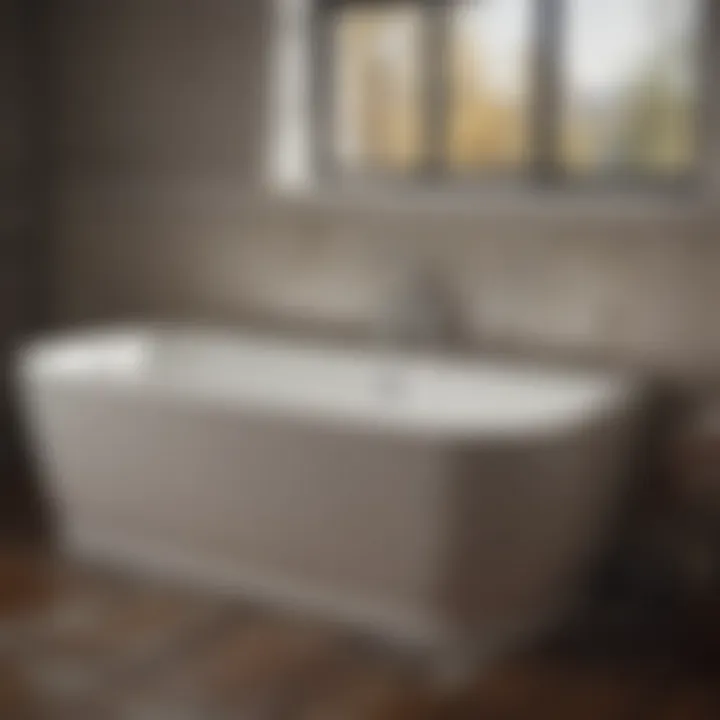
Matching Modern Trends
In today's design landscape, trends continually evolve, and the ability to adapt spaces to fit contemporary aesthetics is crucial. Reglazing opens a world of possibilities when it comes to matching modern trends. Homeowners have the potential to choose from various colors and finishes that align seamlessly with current styles—matte black, glossy white, or even pastel shades. Such flexibility allows individuals to create a bathing oasis that feels fresh and inviting. Plus, reglazing can be done quickly, giving an instant facelift that matches your desired theme.
The critical characteristic here is customization. Homeowners can handpick colors to match fixtures or wall tiles effortlessly. However, one must note the balancing act—while reglazing provides flexibility, it may not appeal to those looking for radical design changes or different materials altogether.
Customization Options
Another aspect worth considering is the sheer range of customization options during the reglazing process. Different finishes can enhance the functionality and style of a bathtub, making it more than just a spot to scrub up. For instance, adding textures or varying gloss levels can change both the look and feel of the surface.
One unique feature of customization in reglazing is the ability to incorporate patterns or stencils, depending on the service provider. This makes your bathtub a unique centerpiece that caters to your aesthetic vision without a complete overhaul in renovation. However, potential disadvantages could arise—some customizations may affect the durability of the finish. If not done properly, they can also lead to discolored patterns over time.
In summary, when considering reglazing versus replacement, analyzing cost, durability, and design flexibility reveals contrasting yet compelling arguments for both practices. Whether you lean towards preserving your existing tub or starting anew, make the decision that suits your style, budget, and longevity needs.
Professional vs. DIY Reglazing
When it comes to bathtub reglazing, deciding between hiring a professional or taking the DIY plunge is a crucial step. Both routes come with their own set of advantages and possible downsides, and understanding these can save homeowners both time and money in the long run.
Evaluating Skill Levels
Considering your own skill level is vital before diving into the reglazing process. There are those who whip out a paintbrush and think they can handle anything, while others might break out in a cold sweat just at the thought of it. Let’s be honest; reglazing demands more than just speculation about painting the walls.
- Beginner DIYers: Most likely you'll find folks whose idea of home repair includes plopping down a new shower curtain. For these individuals, it’s reasonable to recognize the complexities in reglazing. Working with chemicals and tools can stray into dangerous territory without proper know-how.
- Intermediate Hobbiests: If you’ve tackled various home projects, you might feel a bit more confident. Yet, until you’ve worked on a similar task, you might underestimate the meticulous preparation needed. Accurate surface restoration can take time and patience.
- Experienced DIYers: If you’ve experienced roller-coaster rides with epoxy, or you have renovated spaces before, you might consider taking on reglazing as another conquest. However, be prepared for the possibility of unforeseen complications. The art in reglazing often lies in managing the surprises that pop up.
Cost Considerations
Money talks, and for a lot of homeowners, it’s a key factor in deciding between professional and DIY reglazing.
- DIY: The cost of DIY reglazing generally comes down to purchasing the right supplies, including epoxy kits, sandpaper, and safety gear. Expect to pay anywhere from a few hundred dollars for a basic kit to more if you want quality materials. While looking for bargains might seem tempting, remember—safety gear and high-quality reglazing materials are not areas to skimp.
- Professional Services: Engaging a professional might take a bigger bite out of your wallet, often ranging from $300 to $1000 depending on the job's complexity and your location. But here’s the kicker: when you hire pros, you gain access to their expertise, saving potential foot-in-mouth moments when the repair goes awry.
Time Investment
Let’s not forget time is a precious commodities, often stretching thinner than last week's t-shirt.
- For DIY Reglazing: You might start off all energized, but between cleaning, sanding, applying layers, and waiting for curing, you may find your weekend plans going down the drain. On average, a DIY project could take anywhere from several hours to a couple of days to complete, especially with the meticulous nature of the process. Balancing work, family, and home upkeep can lead to significant delays.
- When Going Professional: A qualified technician typically gets the job done efficiently, with most completed in a single day. This can help ease stress levels even if the financial cost is higher. Plus, knowing the job is done right means you can enjoy your bathing sanctuary without lingering worry.
In summary, weighing the options of professional versus DIY reglazing boils down to your skill level, budget constraints, and time availability. Each route brings its challenges and it’s essential to choose a path that aligns with your comfort and capacities.
"Reglazing is not just another home chore; it’s an art that requires knowledge, patience, and sometimes, a gentle guiding hand."
Making an informed decision can turn a daunting task into a refreshing bath experience.
Safety Measures in Reglazing
In the realm of bathtub reglazing, ensuring safety cannot be overstated. This process, while essential for giving a bathtub a new lease on life, involves various materials and techniques that could pose risks if not handled correctly. Homeowners should prioritize safety measures to protect themselves and their living spaces from unwarranted damage. Let's break down two critical aspects of safety that should be kept in mind: protective gear and chemical safety.
Protective Gear
When it comes to safety, protecting oneself during the reglazing process is a must. Here’s a short checklist of protective gear you should consider:
- Respirator Mask: Protects against inhaling harmful fumes from reglazing materials.
- Safety Goggles: Safeguards the eyes from splashes and dust.
- Gloves: Nitrile gloves are recommended to prevent contact with chemicals.
- Coveralls: Wearing protective suits or coveralls can keep your clothes clean and protect skin from splashes.
Using proper gear protects not only the individual performing the work but also helps to maintain a safe home environment. A little preparation goes a long way. Imagine attempting to reglaze without gloves and ending up with itchy skin. That’s a headache nobody wants!
Chemical Safety
Chemical safety is another cornerstone of the reglazing process. Familiarity with the substances you're dealing with can make all the difference. Many reglazing products contain strong chemicals that can be hazardous. Here’s what to keep in mind:
- Ventilation is Key: Always work in a well-ventilated area. Open windows and use fans to circulate air. Poor ventilation leads to the buildup of fumes, posing health risks.
- Follow Manufacturer Instructions: Every product comes with guidelines. Ignoring the recommended safety precautions can lead to adverse outcomes, both in terms of health and the success of the reglazing.
- Storage Practices: Store chemicals securely and out of reach of children and pets. Improper storage can lead to accidents, like spills or ingestion.
"Safety is not just a priority but a practice in the reglazing world which, if overlooked, can lead to perilous situations."
By taking these precautions, you establish a safer work environment that decreases the likelihood of accidents or health issues arising from chemical exposure or mishaps. Ignoring safety measures can turn a simple home renovation into a nightmare.
Aftercare and Maintenance
After a bathtub has been reglazed, the importance of aftercare and maintenance cannot be overstated. This final step not only helps to preserve the freshness of your newly restored bathtub but also prolongs its lifespan. Proper aftercare ensures that the investment made in reglazing does not diminish too quickly. After all, nobody wants their hard work and money to go down the drain.
Cleaning Recommendations
Once your bathtub has been reglazed, it’s crucial to adopt a cleaning routine that protects its surface and maintains its shine. Here are some recommendations that should become part of your regular cleaning regimen:
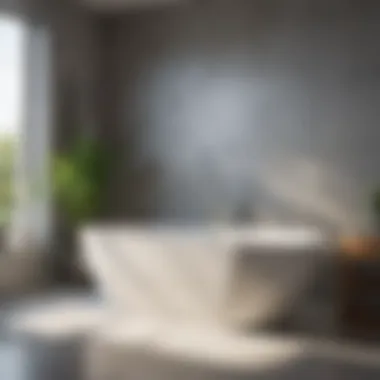
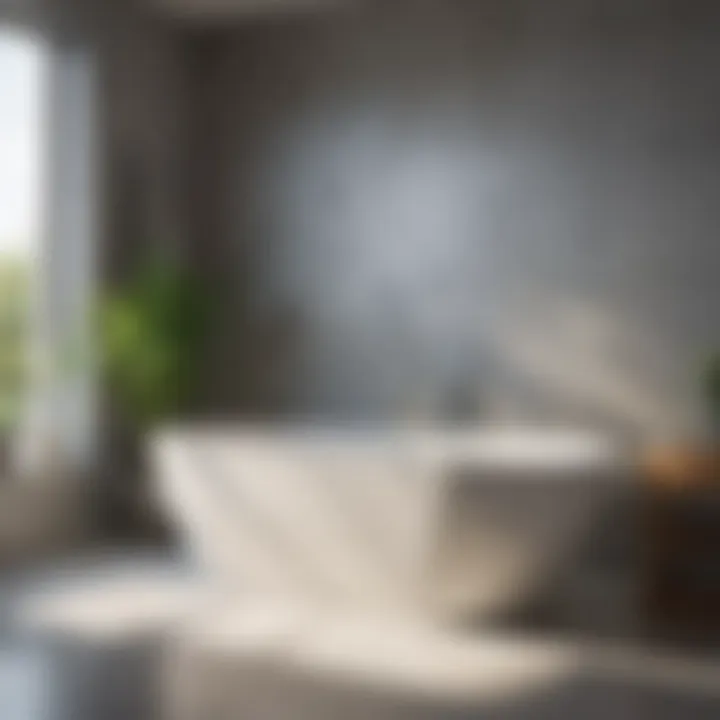
- Use Non-Abrasive Cleaners: Only opt for cleaners that are specifically labeled as non-abrasive. Cream-based cleaners or soft liquid soaps work well and are generally safe for reglazed surfaces. Avoid anything with bleach or harsh chemicals.
- Soft Cloths or Sponges: When you clean the tub, use soft cloths or sponges instead of scrubbing pads. This prevents scratching, which can undermine the smooth surface you just achieved.
- Rinse Thoroughly: Water and soap residue left sitting in the bathtub can lead to soap scum buildup. Always rinse the tub well after each cleaning session to keep it looking pristine.
- Regular Wiping Down: Make it a habit to wipe down the tub after each use. This prevents dirt buildup and helps keep your bathtub in tip-top condition. A simple microfiber cloth can work wonders in this regard.
Preventing Damage
The ideal next step is to employ preventive measures that can mitigate the chances of damage occurring on your fresh reglaze. Here’s how you can ensure your bathtub maintains its integrity for years to come:
- Avoid Heavy Items: Refrain from placing heavy objects in the tub and avoid standing on the edges. This can produce chips or cracks in the surface.
- Use Bath Mats: Employing non-slip bath mats can help protect the surface from scratches as well as provide safety. Just be cautious to choose mats that do not grip too tightly to the surface.
- Control Water Temperature: Hot water may seem inviting; however, extremely hot water can weaken the glaze over time. It's prudent to maintain a moderate temperature.
- Address Molding ASAP: If you notice any signs of mold or mildew, tackle it immediately. These can degrade your reglaze; hence, acting quickly is in your best interest.
"A little care can go a long way in preserving the quality of your reglazed bathtub."
By following these aftercare and maintenance guidelines, your reglazed bathtub will not only look like a million bucks but will also serve you well for many years, providing a cozy oasis in your home. A little diligence goes a long way, helping you keep the beauty and functionality that was restored during the reglazing process.
Real-Life Case Studies
Real-life case studies shine a light on the practical side of bathtub reglazing, showcasing how theory unfolds in real-world scenarios. These examples not only serve as evidence of successful projects but also reveal common pitfalls and considerations that can help future homeowners and renters make informed choices. By examining various instances of bathtub reglazing, readers can grasp the tangible benefits, challenges, and the overall impact on living spaces.
Successful Reglazing Projects
In the world of home improvement, there are many triumphs. One homeowner from Texas decided her old, chipped acrylic bathtub was more eyesore than oasis. After researching, she chose to reglaze instead of replace. The process was a breeze, and just 48 hours later, she was soaking in a gleaming white tub.
The cost savings were significant—she spent about one-third of what a new tub would have cost. Not only did it breathe new life into her bathroom, but it also increased the property value. Such stories underscore the potential of successful reglazing projects; they can transform a dull bathroom into a stunning retreat without breaking the bank.
Here are other notable perks from successful projects:
- Quick Turnaround: Most projects are completed in a day.
- Custom Color Options: Homeowners often choose colors to match their decor.
- Eco-friendly: Keeping the original tub reduces waste.
Challenges Faced During Reglazing
On the flip side of the coin, not every reglazing project sails smoothly. Consider the tale of a couple in California who newly bought an older home. Eager to rejuvenate the bathroom, they decided to hire a professional for the reglazing. However, they neglected to check the surface preparation; this led to peeling within weeks.
Several challenges often crop up in these kinds of projects:
- Surface Prep Complexity: As mentioned, inadequate preparation can lead to disastrous results.
- Time Constraints: Sometimes, performers misjudge the required time, which delays use.
- Product Selection: Mixing incompatible products can cause issues with adhesion.
"In a project, attention to detail is not just a good habit; it's a necessity."
In summary, real-life case studies provide invaluable insights into both the achievements and challenges of bathtub reglazing. By learning from others, homeowners can better navigate their own reglazing projects with a realistic lens.
Industry Trends
The landscape of bathtub reglazing has taken some interesting turns in recent years. With such a focus on home improvement and sustainability, it is crucial to keep an eye on the trends transforming this particular industry. Not only do these trends reflect consumer preferences, but they also serve as indicators of technological advancements and evolving design philosophies.
Emerging Techniques and Technologies
Innovation never seems to take a backseat. Lately, we have seen a few exciting leaps in techniques and tools used for reglazing bathtubs. One of the most significant developments is the use of high-performance coatings that not only provide a fresh look but also enhance durability. These advanced materials often contain a harder finish that can withstand daily wear and tear, ensuring that the reglazed surface remains attractive for years to come.
Additionally, spray-on technology has gained traction. Unlike traditional brush methods, which may leave streaks or uneven finishes, this new method allows for a smooth application, creating a flawless appearance. Homeowners are increasingly drawn to these technologies, as they provide a clean finish and often reduce the time needed for the entire process.
With safety being a must, low-VOC (volatile organic compounds) products are gaining popularity among professionals and DIY enthusiasts alike. These products not only offer a safer working environment during application but also contribute to healthier indoor air quality post-reglazing. Homeowners tend to prefer these greener options, aligning with a broader movement toward eco-friendly home improvement practices.
Influence of Design Trends
Bathtub reglazing, much like fashion, is affected by popular design trends. Right now, there’s a strong inclination towards minimalist aesthetics and sophisticated color palettes. Crisp whites and soft pastels are making a comeback, captivating those yearning for a clean and tranquil bathing experience. Homeowners are eager to complement their modern interiors with bathtubs that possess both flair and functionality.
Another design trend that is reshaping reglazing preferences is the rise of textured surfaces. While glossy finishes were once all the rage, textures add depth and a unique character to bathrooms. Subtle textures can create a sophisticated feel, making even an older bathtub look quite upscale.
Moreover, customizing colors to fit personal styles is gaining traction. Homeowners want their bathtubs to not just serve a purpose but also to reflect their individuality. The demand for bespoke reglazing solutions has led many professionals to offer custom color matching as part of their services.
"Today's consumer doesn't simply want a functional bathtub; they are after a statement piece that resonates with their home environment."
So, as you can see, staying updated with the emerging techniques and trends in bathtub reglazing can systemically improve the quality of outcomes homeowners experience. Adapting to these changes allows for better options in aesthetics, functionality, and environmental consciousness, making for a more enticing bathroom sanctuary.
Ending
When it comes to making decisions about home improvements, especially in high-use areas like bathrooms, the topic of bathtub reglazing emerges as a vital consideration. Choosing to reglaze rather than replacing a bathtub can yield significant benefits, both economically and environmentally.
Take a moment to think about it: many households face the dilemma of whether to ditch that old fixture or to breathe new life into it. reglazing offers a practical solution that allows homeowners to save money while minimizing waste, which is increasingly crucial in today's environmentally-conscious world.
Final Thoughts on Reglazing
In wrapping things up, let’s consider the broader implications of bathtub reglazing. It's more than just a mere cosmetic upgrade; it’s about sustainability and preserving the integrity of one’s home.
- Cost-Effective Solution
Reglazing costs a fraction of what a full replacement would run. For many families, this option can put extra cash back in their pockets without skimping on aesthetics. - Quick Turnaround
Unlike remodeling that can stretch over weeks, reglazing typically takes just a few hours. This is a blessing for busy households juggling multiple responsibilities. - Gorgeous Results
When done right, a reglazed tub can look practically brand new. Selecting hues and finishes that align with modern design trends lets homeowners personalize their space without the lengthy renovation process. - Less Stress
The thought of replacing a bathtub conjures images of extensive construction work and mess. Reglazing is a relatively clean process, requiring minimal disruption to daily life.
In essence, bathtub reglazing represents a harmonious blend of practicality and beauty, appealing to those who wish to preserve their spaces while managing time and budgets effectively. Though it may seem like a small decision, it can resonate deeply with the overall aesthetics and functionality of your home's bathing area.
As with all home improvement projects, it’s critical to weigh the pros and cons, do thorough research, and consider personal priorities. With n the right approach, reglazing can transform not just your bathtub, but also contribute positively to the ambiance of your entire bathroom.



